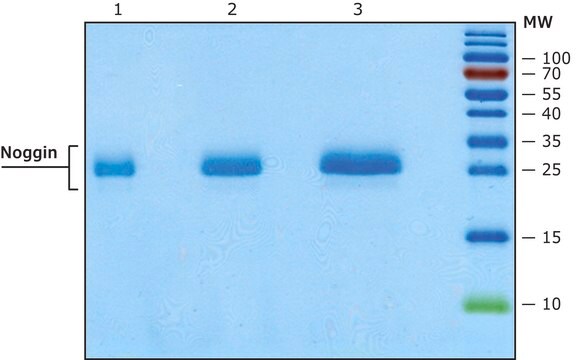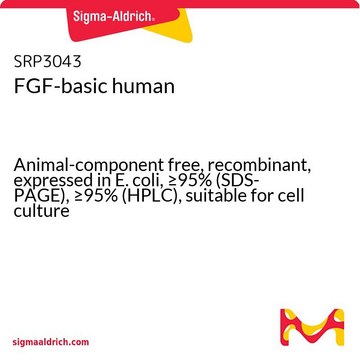SRP3040
FGF-9 human
recombinant, expressed in E. coli, ≥95% (SDS-PAGE), ≥95% (HPLC), suitable for cell culture
Sinónimos:
Fibroblast Growth Factor-9, GAF (Glia-activating factor), HBGF-9
Iniciar sesiónpara Ver la Fijación de precios por contrato y de la organización
About This Item
UNSPSC Code:
12352202
NACRES:
NA.32
Productos recomendados
biological source
human
recombinant
expressed in E. coli
assay
≥95% (HPLC)
≥95% (SDS-PAGE)
form
lyophilized
potency
≥2x10^6 units/mg
mol wt
23.4 kDa
packaging
pkg of 20 μg
technique(s)
cell culture | mammalian: suitable
impurities
<0.1 EU/μg endotoxin, tested
color
white to off-white
UniProt accession no.
shipped in
wet ice
storage temp.
−20°C
Gene Information
human ... FGF9(2254)
General description
FGF9 (fibroblast growth factor 9) is a member of the FGF family, which consists of a minimum of 24 members. This protein is highly conserved across species, and the gene is localized to human chromosome 13q11-q12. In embryos, FGF9 mRNA has a ubiquitous expression pattern. In adults, this protein has a limited range of expression in normal conditions, and expression is usually restricted to brain, kidney and uterus.
Recombinant human FGF-9 is a 23.4kDa protein consisting of 207 amino acid residues.
Recombinant human FGF-9 is a 23.4kDa protein consisting of 207 amino acid residues.
Biochem/physiol Actions
FGF9 (fibroblast growth factor 9) is expressed in the epithelium and mesothelium of developing lung in the pseudoglandular stage. In developing lungs, it regulates the branching of epithelium, proliferation of mesenchymal cells, and expansion of the lungs. It is overexpressed in patients with idiopathic pulmonary fibrosis (IPF), in regions demonstrating active cell hyperplasia, metaplasia and fibrosis. Thus, it might facilitate the pathogenesis of IPF. The expression of this protein is up-regulated in colon cancer, which is an outcome of hypoxia-induced translational activation.
Sequence
MAPLGEVGNY FGVQDAVPFG NVPVLPVDSP VLLSDHLGQS EAGGLPRGPA VTDLDHLKGI LRRRQLYCRT GFHLEIFPNG TIQGTRKDHS RFGILEFISI AVGLVSIRGV DSGLYLGMNE KGELYGSEKL TQECVFREQF EENWYNTYSS NLYKHVDTGR RYYVALNKDG TPREGTRTKR HQKFTHFLPR PVDPDKVPEL YKDILSQS
Physical form
Lyophilized from 10 mM Sodium Phosphate, pH 7.8 + 50 mM NaCl.
Reconstitution
Centrifuge the vial prior to opening. Reconstitute in water to a concentration of 0.1- 1.0 mg/ml. Do not vortex. This solution can be stored at 2-8°C for up to 1 week. For extended storage, it is recommended to further dilute in a buffer containing a carrier protein (example 0.1% BSA) and store in working aliquots at -20°C to -80°C.
Storage Class
11 - Combustible Solids
wgk_germany
WGK 3
flash_point_f
Not applicable
flash_point_c
Not applicable
Elija entre una de las versiones más recientes:
¿Ya tiene este producto?
Encuentre la documentación para los productos que ha comprado recientemente en la Biblioteca de documentos.
Emily Coffey et al.
The journal of histochemistry and cytochemistry : official journal of the Histochemistry Society, 61(9), 671-679 (2013-06-26)
The fibroblast growth factor (FGF) family of signaling ligands contributes significantly to lung development and maintenance in the adult. FGF9 is involved in control of epithelial branching and mesenchymal proliferation and expansion in developing lungs. However, its activity and expression
Tsung-Ming Chen et al.
Nucleic acids research, 42(5), 2932-2944 (2013-12-18)
Human fibroblast growth factor 9 (FGF9) is a potent mitogen involved in many physiological processes. Although FGF9 messenger RNA (mRNA) is ubiquitously expressed in embryos, FGF9 protein expression is generally low and restricted to a few adult organs. Aberrant expression
Sung Mi Cho et al.
The Journal of biological chemistry, 290(47), 28502-28514 (2015-09-26)
Cyanobacteriochromes (CBCRs), which are exclusive to and widespread among cyanobacteria, are photoproteins that sense the entire range of near-UV and visible light. CBCRs are related to the red/far-red phytochromes that utilize linear tetrapyrrole (bilin) chromophores. Best characterized from the unicellular
Chao Sun et al.
BMC cancer, 15, 333-333 (2015-05-01)
Cancer-associated fibroblasts (CAFs), which reside around tumor cells, are suggested to play a pivotal role in tumor progression. Here we performed microarray analyses to compare gene expression profiles between CAFs and non-cancerous gastric fibroblasts (NGFs) from a patient with gastric
Fibroblast growth factors.
Ornitz, D.M., et al.
Genome Biology, 2, 30051-300512 (2001)
Nuestro equipo de científicos tiene experiencia en todas las áreas de investigación: Ciencias de la vida, Ciencia de los materiales, Síntesis química, Cromatografía, Analítica y muchas otras.
Póngase en contacto con el Servicio técnico








